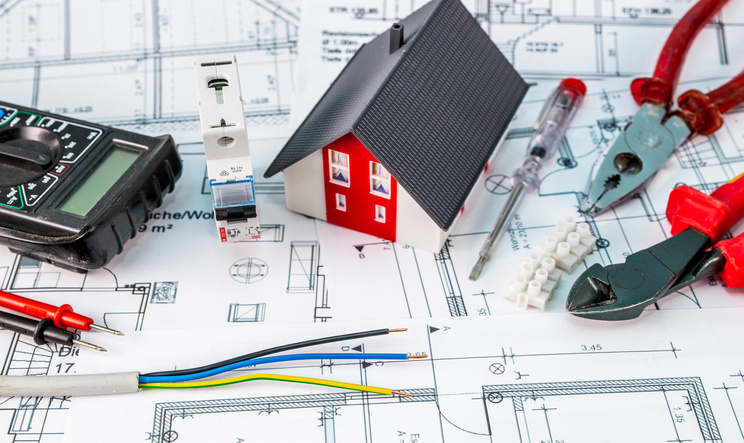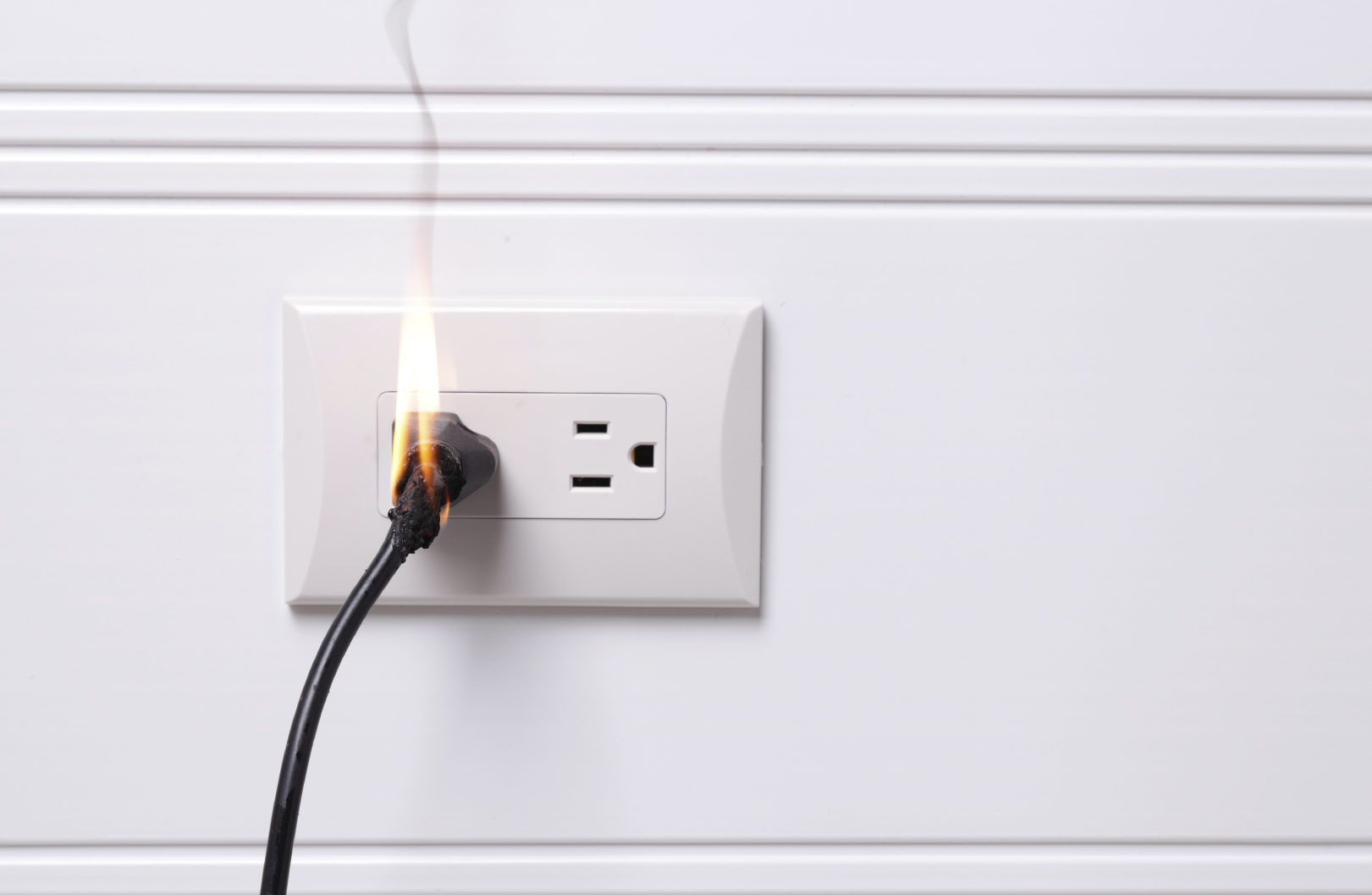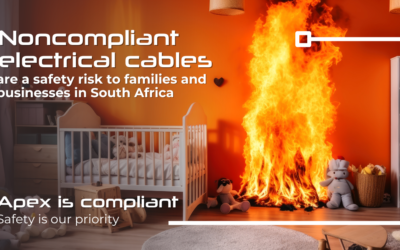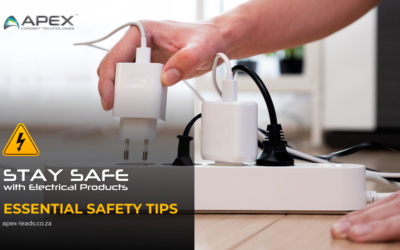The SAFEhouse Association is a non-profit, industry organisation committed to the fight against sub-standard, unsafe electrical products and services.
There is present in South Africa a considerable number of electrical products that are:
1. non-compliant with regulations or quality standards,
2. otherwise of poor quality,
3. potentially unsafe,
4. misrepresented,
5. not fit for purpose,
6. counterfeit,
7. offered at seductive prices, or
8. dangerous.
The SAFEhouse Association has been formed by organisations within the South African electrical industry to combat the prevalence of unsafe products and services in South Africa.
Safe House Basics
It is very important to note that any electrical work or installation must be undertaken by a qualified and registered electrician. This section is intended to give the reader a general understanding of an electrical installation and its principles.
How safe is safe
Safeguard your home and workplace from an electrical perspective
Prepare and Prevent
DON’T REPAIR AND REPENT.
Be aware of the dangers of Electricity.
Someone once said the door to safety hinges on common sense. It makes perfect sense to first have an understanding of the dangers of electricity before you can take precautions against them. The two primary electrical threats are electric shock and fire. Let’s take a closer look at these…
Electric shock
An electric shock is a negative physiological (trauma) or physical reaction (injury) that is caused by an electrical current that passes through a person’s body. This typically occurs when a person comes in direct contact with live wires of an electrical circuit, or with any conductive material such as metal that has become electrically charged.
How serious is it?
The severity of an electrical shock is subject to a number of different elements, such as the strength of the electrical current, how it passed through the victim’s body, for how long the victim was exposed to it and whether the victim’s skin was wet or dry. The reason for the latter is that water is a good conductor of electricity, or simply put, electricity flows through water much easier.
The body will respond to the electric shock in direct proportion to the severity of it. A minor shock, for example, might only cause a slightly uncomfortable tingling sensation. A moderate shock might cause burns and a major shock could make the heart stop altogether.
The table below illustrates the ratio of the strength of the current versus the degree of the injury:
*(Please note that a standard electrical circuit provides an average of 20,000 milliamperes of electricity)
| Strength of Electric Current |
Physical Reaction or Type of Injury |
| 1 Milliampere | Awareness |
| 5 Milliamperes | Minor shock that might be uncomfortable, but not necessarily painful |
| 6 – 30 Milliamperes | Painful shock that might make it impossible for the victim to let go of the electrically charged object |
| 50 – 150 Milliamperes | Acute pain, may stop breathing or experience muscle spasms |
| 1000 – 4,300 Milliamperes | Erratic heartbeats or ventricular fibrillation |
| 10,000+ Milliamperes | Heart may stop functioning (cardiac arrest, acute burns may occur and the victim could die) |
Fires and other hazards caused by electrical malfunctions
Apart from causing electric shocks, sparks from malfunctioning electrical equipment may set flammable or explosive materials on fire. In addition, there are also dangers attached to the sudden loss of power. For example, if a refrigerator suddenly stops working, it can discharge toxic or flammable gases and if magnetic or mechanical industrial equipment fail, some of the chemical reagents may be compromised.
SAFEGUARD YOUR HOME AND WORKPLACE FROM AN ELECTRICAL PERSPECTIVE
Every year, electrical malfunctions such as these mentioned above, cause a vast number of fires, substantial property damages, thousands of personal injuries and hundreds of deaths worldwide. The importance of electrical safety at home and in the workplace can therefore not be overemphasised.
Let’s take a look at what you can do to safeguard your space from an electrical perspective and how safe is safe exactly…
Eliminating Electrical Risks
This includes methods to insulate electric cables, guard the live electrical parts on a circuit and limit the current that can flow to the earth, as well as the usage of protection devices.
Here is a basic checklist of the minimum precautionary steps that should be taken in every workplace:
- Check all electrical equipment and wiring for faults before using it. Any damaged or worn out electrical cables should be replaced straight away.
- Make sure that all workers are aware of where the circuit breaker panels are and how to shut it down in the case of an emergency, such as an electric shock or a fire.
- Steer clear from using water or chemicals close to electrical equipment, for as far as possible.
- Adhere to the minimum safety health and safety standards for electricity in the workplace. For your convenience, these standards are outlined here below.
Levels of Protection
Cable insulation
Electricity is a vital source of energy that powers much of our lives when channeled correctly. But ironically, touching live electricity can shock, injure, burn or kill. A simple way to prevent this as far as possible is through cable insulation.
The Safey Standards
Safety does not happen by accident. All electrical installations should adhere to the electrical safety standards as prescribed by the applicable laws and governing bodies in our country and all premises must have updated and valid certificates of electrical compliance.
Do check that your electrical contractor complies with the relevant section of the Occupational Health and Health Act (OHS Act), the South African Bureau of Standards Code of Practice SANS 10142-1Code of Practice for The Wiring of Premises, as well as Eskom’s minimum requirements.
Main Switchboard
The entire electrical installation is controlled by this board which contains all the over current protection circuit breakers, Isolators and the earth leakage protection unit.
Each circuit should be neatly labeled so that it can be easily identified which is absolutely essential when determining where a fault has occurred:
When a ‘Socket outlet’ circuit breaker trips:
The instinctive reaction is to switch the breaker back on, however this is not a good idea as the fault may still be present and could be aggravated, possibly causing a fire, here is a less risky approach.
- Determine the area affected and unplug all appliances that are plugged into that circuit. Generally if the appliance has developed a fault, some evidence of the electrical “burn out” is visible by a telltale black sooty deposit.
- Switch the circuit breaker back ON. If it trips immediately, then the problem lies in the wiring and it is best to leave the breaker OFF and call your Electrician.
- If the breaker stays ON and no visible signs of a fault can be seen, then plug each appliance back into the circuit and switch it on, proceed with this until the circuit breaker trips again – that would then be the faulty appliance. However, some faults may have cleared themselves and the appliance works normally, in which case the breaker would not trip again, or the appliance is ‘open circuit’ and consequently does not work and also will not trip the breaker.
When a ‘Lights’ circuit breaker trips:
The same caution should be applied.
- Determine the area affected and switch OFF all the light switches in that area.
- Switch the circuit breaker back ON. If it trips immediately, then the problem lies in the wiring and it is best to leave the breaker OFF and call your Electrician.
- If the breaker stays ON, then switch each light switch back ON, proceed with this until the circuit breaker trips again – that would then be the light circuit. However, some faults may have cleared themselves and/or the globe has become open circuit, in which case the breaker would not trip again and the problem should be resolved by replacing the globe.
- Be mindful of any electronic devices such as ‘built in’ dimmers and timers which may have malfunctioned, in such a case, call your Electrician – do not attempt to repair or replace the wall switch assembly yourself.
When the ‘Stove’ circuit breakers trips:
The same caution should be applied:
- Switch the Stove and Oven (if separate) Isolator(s) OFF. Switch all the stove plates, oven elements and fans OFF.
- Switch the circuit breaker back ON. If it trips immediately, then the problem lies in the wiring and it is best to leave the breaker OFF and call your Electrician.
- If the breaker stays ON, then switch each plate, element and fan, individually. Should any of this cause the breaker to trip, then that would be the faulty plate or element. You could leave it OFF and proceed to use the other plates or elements whilst waiting for the stove to be repaired.
When the ‘Geyser’ circuit breakers trips:
The same caution should be applied:
- It is best to call your electrician or plumber, as it is not advisable to work on the geyser unless qualified to do so.
House Wiring
Safety:
Wires are conductors of electricity and are therefore dangerous when exposed and especially when the insulation has been damaged in any way.
The electrical circuits are often not easily recognized by exposing wiring at any point along the conduit installation. Any changes may alter the polarity to the appliance or outlet and increase the risk of reduced electrical protection to the user.
Certificate of Compliance (CoC):
All electrical installations would have been issued with a detailed COC, by the contractor that carried out the work and tested it, in accordance with the ‘Wiring Code’. Consequently any changes to the installation, by anyone other than a qualified Electrician, will render the COC null and void.
Socket Outlets
Another safety feature that has been fitted to each socket outlet is the Safety Shutter. This prevents the insertion into the Live and Neutral socket entry holes, by the action of a plastic component, which in some cases, may be operated by the Earth pin of the plug.
There are certain precautions that need to be taken:
- Check that the shutter works properly and does not expose any of the entry holes, other than the Earth one.
- Always switch the socket ‘OFF’ before plugging or unplugging an appliance into the socket outlet.
- Always check that the plug is not damaged in any way or the plug pins have dirt or any substance attached that could be transferred to the socket contacts, inside the socket outlet.
- When cleaning the socket outlet faceplate, use a soft soap on a slightly moist cloth; avoid water entering the socket outlet by way of the socket entry holes or the switch surround.
Cord Extension sets and Reels
This insulation can easily be, scuffed, shaved, punctured and sometimes cut by the most obvious events. The exposure of the inner conductors can cause injury, and electrical fires.
There a certain precautions that needs to be taken:
- From time to time, check the surface of the extension cord throughout its length; replace it if any exposed copper conductors are evident.
- Where the cord is used temporarily, ensure that it is not trodden on by arranging a “protective cover” over the portion exposed to traffic.
- Where a more ‘long term’ extension is required, ensure that the cord is fixed to the wall, out of the way of any traffic, by neatly spaced cable cleats of the correct size.
- Regularly check the state of the socket outlet and ensure that the shutters are operating correctly, check the plug pins for damage and adhesion of dirt and grime.
- Electrical cords near an open fire such as a braai area should be avoided and kept at a safe distance.
- When using an extension reel, ensure that the cable is fully ‘un-reeled’ as to avoid the increased heating effect caused by the inductance of a coil carrying current.
- Caution is advised on the use of the correct rating, especially for cord extensions that are rated at 10A, check the appliance that needs to be plugged into the extension cord, especially heaters, which could require currents around the 8A level, a 10m extension cord would not be suitable in such a case and one would be advised to use a shorter version or one rated at 16A.
Plug-in Adaptors
Invariably there are many more appliances than socket outlets and the use of plug-in adaptors neatly solves this problem. Also, due to the different plug configurations that are not always found on the wall socket outlets, a multiple adaptor is essential.
South Africa has 9 Legal Plug and Socket configurations
These are:
SANS 164-1:
Plugs and socket outlets for household and similar purposes for use in South Africa –
PART1:
Conventional System, 16A 250V a.c.
The most common plug and socket in use in South Africa originated from the old British System BS 546, with some small differences in pin lengths. It has been in use for the past 80 years, metricated in 1953 and revised in 1980. Britain replaced this standard with the “flat pin” fused plug BS1363 in 1947.
SANS 164-2 Plugs and socket outlets for household and similar purposes for use in South Africa –
Part 2 :
IEC System, 16A 250V a.c.
In the 1980s SA decided to introduce the IEC worldwide plug and socket system, based on IEC 60906:1986, which had been under development by the international community from 1966.
Arguably the SAFEST system in the world the socket outlet is mainly used in SA due to the fact the it accommodates cell phone chargers and 2-pin EUROPLUGS fitted to small power devices such as hair dryers etc.
The main feature of its design is that the socket is shuttered and has a 12mm pocket which makes it impossible to touch a live pin during plug insertion:
SANS 164-2 also caters to a 16A, 2-pin system that is extensively used in adaptors and is intended for Class II appliances and power tools.
The standard allows the connection of an unearthed plug into an earthed socket but not vice versa – as this is a dangerous situation where an appliance that requires a protective earth, would be unearthed, which under fault conditions could cause fire or an electrocution.
SANS 164-3:
Plugs and socket outlets for household and similar purposes for use in South Africa –
Part 3:
Conventional System, 6A 250V a.c.
The 6A plug and socket has also been in use for the past 80 years, now used extensively for the connection of luminaries, in its non-rewireable form.
The 6A, 2-pin version has been dropped several years ago together with the 2-pin “flat-faced” socket which was commonly found on adaptors.
As plug circuits are rated at 16A and protected by a 20A circuit breaker, this system fell out of favour for fixed installations.
SANS 164-4: Plugs and socket outlets for household and similar purposes for use in South Africa –
Part 4:
Dedicated System, 6A 250V a.c.
Dedicated systems are used for the connection of equipment such as computers to special power supplies that have uninterruptible or “clean power” characteristics, either from a special transformer or a battery/inverter system that takes over in the case of a power failure.
The dedicated earth pin has 3 possible types, determined by the rotational position of the flat portion: i.e
– 53o BLACK
0oRED and
+53o. BLUE
Colour nomenclature is also an integral requirement
The main advantage of this system is that the dedicated plugs cannot be interchanged (within the dedicated configurations) but may be inserted into the standard (non-dedicated) system – SANS 164-1.
SANS 164-5: Plugs and socket outlets for household and similar purposes for use in South Africa –
Part 5:
Two-pole, non-rewireable plugs, 2,5A 250V a.c., with cord, for connection of class II equipment.
A 2,5A plug of the EUROPLUG design has smaller diameter contact pins than those in the 16A (SANS 164-2) version.
And is extensively used in cell phone chargers. It is compatible with SANS 164-2 and SANS 164-6, both standards make provision for contact integrity between the two pin sizes. However, because of the compatibility of plugs of a higher current rating, a 2,5A socket has not been allowed for obvious reasons.
SANS 164-6: Plugs and socket outlets for household and similar purposes for use in South Africa –
Part 6:
Two-pole, systems, 16A 250V a.c., for connection of class II equipment.
The Schuko system, which is common to many European countries, has been the subject of many heated debates to the point where the Minister published a mandatory prohibition on the use of the earthed plug (VC8008: 1994). The main reason lies in the fact that many unearthed 2-pin adaptors will accommodate an earthed plug, with potentially dangerous consequences. A 2-pin (Earthed and Unearthed) socket is allowed in adaptors and also in fixed installations. The standard is taken from CEE 7/17 and the use of this plug is limited to a non-rewireable type
Stove Isolator
In accordance with the ‘Wiring Code of practice’ Each permanently connected (fixed) appliance must have a Switch Disconnector (isolator) within arm’s reach of the appliance, which disconnects both Live and Neutral supply to it.
The Isolator is usually rated between 30A and 60A depending on the stove rating and in certain applications may be 3-phase.
This is a safety measure and should be switched off whenever the stove or oven is being cleaned, or in the case where maintenance of any kind is undertaken.
There are certain precautions that need to be taken:
- always switch the isolator ‘OFF’ when cleaning the stove or oven.
- When cleaning the isolator faceplate, use a soft soap on a slightly moist cloth; avoid water entering the isolator through the isolator surround.
Socket Outlet – Dishwashing and Laundry Machine
Connection to Dishwashing and Laundry Machines: These handy appliances generally use high currents to operate, sometimes for short times, during their programmed cycles.
Currents between 8 and 12A are quite common and although the wiring is perfectly adequate for this, one often is tempted to combine these machines on one plug by using a cord extension or a plug-in adaptor.
There are certain precautions that need to be taken:
- Always use a cord set with a 16A rating.
- Avoid the use of plug-in adaptors, if absolutely necessary; use only a ‘double adaptor’ which is rated at 16A.
- Avoid, wherever possible, using two or more machines at the same time.
Pool Pump
- The Pump and control-gear installation must be on or beyond zone 2 which is a minimum of 2m from the pool’s edge.
- The Control box must be of suitable IP protection rating.
- The Pump must be supplied via an Earth Leakage protection unit with a maximum tripping current of 30mA.
- The pool lighting is to be supplied via an isolating transformer with 12V maximum output to the light.
It is most important to the safety of you and your family that NO 220V appliances are brought close to the pool, or used in its vicinity.
The pool timer is usually set at different schedules for summer and winter, typically with manually chlorinated pools:
Summer: – ON from 8am to 4pm (8 hrs.)
Winter: – ON from 9am to 3pm (6 hrs.)
Light Switches & Dimmers
- Press the switches evenly and without undue force.
- Do not hit switches with force or hard objects. Remember that the plastic is your protection against contact with electrical current.
- Do not splash water or any liquid on the switch.
- To clean, use a damp cloth with a little soap and wipe off any residue with a dry cloth.
Dimmers:
Although most modern light dimmers are capable of dimming various light sources such as Compact Fluorescent tubes and LED’s, not all lamps are dimmable, so take care when purchasing lamps for replacement, that the product is marked as “DIMMABLE”.
Some dimmers are not capable of dimming anything other than incandescent lamps – in this case the lamp may flicker, stay on one setting or not light up at all.
This is especially the case with LED lamps; these generally require a special type of dimmer to enable suitable dimming.
Dimming of fans or any other appliance: This is generally not possible and could lead to the dimmer failing. Fans are normally fitted with a 2 or 3 speed controller, which should be used without adding any other component (such as a dimmer).
Socket outlets for Bedrooms
Currently there are several products available on the market that combines these two configurations as this example:
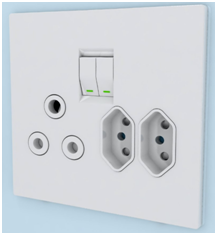 |
This is a better alternative to the use of adaptors and cord extension sets, often lying on the floor or carpet.
It is also good practice not to have small appliances plugged in with the power ON whilst not in use; these should be packed away safely or switched off at the socket outlet.
Socket outlets for Lounge, TV room and Study
It is good practice to do the following:
- In the planning of a new house or installation, chose a ‘cluster’ type multiple socket-outlet which should be fitted behind the entertainment structure or alcove.
- Fit a simple ‘power monitor’ which monitors the main device (say TV set) and it that is off, then it switches off all the other devices.
- Avoid adaptors as far as possible.
Surge Suppression: It is also a good idea to have some form of surge suppression in two ways:
- In the Main Switchboard – this protects the entire installation, referred to as a level II protection, is quite useful but still allows some surges to enter the installation.
- As close as possible to the equipment – this protects the equipment, referred as level III protection, it limits the voltage surge to a lower value and is found in several products such as plugs and cord extension sets.
There are some points to be aware of:
- The surge protection device may reach the end of its useful life by having had dealt with several surges, in which case it will by internal design, be rendered inoperative – this is an important design feature since at the end of their useful life, surge arrestors of the metal oxide varistor (MOV) type, become dangerously hot to the extent that they can ignite.
- Monitor the warning light on the MOV protected product and replace it when this changes state as per the instruction legend.
- Ensure that the protection device complies with the SA standards (SANS 60884-2-5 or SANS 164-0 or SANS 1661, VC8008 or VC8029).
Under-floor heating controllers
Electro-mechanical: comprising of a bimetal thermostat that measures the air temperature, a graduated rotary setting to select the desired temperature and a relay to switch the power to the heating element under the floor.
Electronic: which also has the relay but the temperature controller is a small microprocessor with a solid-state thermal measuring device. The temperature setting is done digitally and the display is usually a small screen or numerical display.
It is generally not recommended to use the air temperature measurement method to control the under-floor heating but rather to make use of temperature sensors fitted into the floor close to the heating element. In this way the actual floor temperature is measured rather than the air above it.
Electricity can kill
Know the dangers
IGNORANCE CAN KILL.
Know the dangers of electricity
Any person who uses electricity at home or in the workplace should be fully aware of the potential harm it can cause if not harnessed correctly. Here’s an overview…
The risks pertaining to electricity can generally be classified into two main categories. They are: direct and indirect.
Direct
When a person accidentally touches live electricity directly, it will lead to a sudden discharge of electricity through the body, which is commonly known as an electrical shock. Subject to the voltage, such an electric shock can cause injury to the body in various degrees of severity. This includes falls, burns, irregular heartbeats, breathing that stops; bodily functions that shut down and finally electrocution or death.
Indirect
Sometimes leakage of electricity or uncontrolled electricity can cause damage to a building which then in turn could seriously harm or even kill the people who are in it. This includes the likes of explosions and fire.
Considering the shocking statistics of fires, deaths and injuries caused by electricity across the globe, we cannot ignore the danger of it. Remember that the best risk is the one you didn’t take. Click here to see how safe is safe and what you can do to safeguard your environment from an electrical perspective.
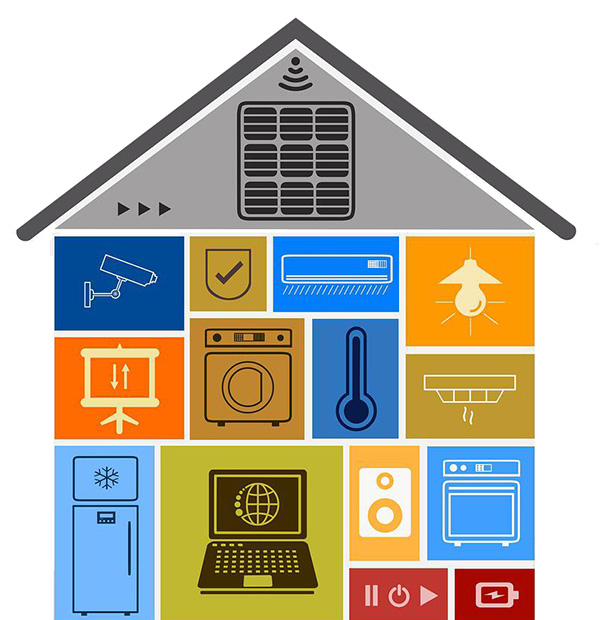
Informative Video Series
Earth Leakage Trip...Here's what to do. (RCD)
This is a short video to show you what to do when the Earth leakage in your house trips.
Electrical Safety Tips
Some important tips for staying safe around your home!
Dangers of Electricity
Explaining all the dangers of electricity using scientific reasoning.
Main Cause of Electrical Fires
One of the main reasons that we carry out PAT Testing is to reduce the risk of fires in a workplace. The Formal Visual Inspection is an important part of maintaining a safe working environment.
Basic First Aid for Electrical Injuries
The first hour after a traumatic injury is referred to as the ‘golden hour’ as this is the period in which emergency treatment is most likely to be successful.
Rendering first aid to a victim of electrical injury until full medical treatment is available, is therefore invaluable.
It is recommended that the following is printed out and clearly displayed in all areas of the workplace where electricity is used and at home.
Call for medical assistance straight away
Any victim of an electrical shock will need medical attention in some form. Call the emergency services such as:
- 0842124 ER24
- 082911 Netcare 911
- 10177
National Emergency Management Service, paramedics or an ambulance immediately to get the injured person to an emergency room as soon as possible.
Remove the person from the source of the power
Switch it off
This is best done by switching the power off straight away. Unplug the electrical appliance in question if it is undamaged or switch the power off at the fuse box or on the electrical distribution board.
Pull the person away
If it’s not possible to shut the power down, you have to physically pull the person away from the electric current. To do so, you have to stand on and use materials that are non-conductors of electricity. For example, stand on a book, wooden surface or newspaper and separate the person from the electricity with a rubber, wooden or plastic item such as a mat, chair or broom.
If you feel a tingling sensation in your legs or lower body whilst trying to separate the person though, rather back off and call your local electricity supply company to switch off the power at the main source.
Eliminate high voltage power
If the incident took place in an industrial area where there are high voltage overhead power lines, you have to call the emergency number of your local electricity supply company and ask them to switch it off. Make sure that this number is handy for when it is needed.
Help the person breathe
Call for help
You could call emergency services and ask for an operator to guide you through CPR instructions telephonically.
Pump
Apply chest compressions by using your hands to push down approximately two centimeters deep into the centre of the victim’s chest. Pump down 30 times at a rapid rate of more than once per second.
Blow
If the victim still does not respond, tilt the head back, lift the chin, pinch the nose and cover the mouth with yours. Then start blowing oxygen into the mouth until the chest starts rising. Blow in for one second at a time and repeat twice.
Alternate pump and blow
Keep on alternating these pump and blow actions until the victim starts breathing or medical help arrives. If there is more than one person on the scene, one can pump while the other blows.
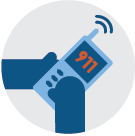
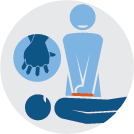
Take heed of risks
The spread of any infection during CPR is extremely rare and evidence shows that you cannot get HIV/AIDS from performing it. The main risk to take note of is the fact that many victims start to vomit during CPR. If this happens, just turn the person’s head to the side and try to wipe away the vomit to avoid suffocation.
Attend to other injuries
Bleeding
If the person is bleeding, use a clean cloth or cloth-like material to apply direct pressure on the wound until the bleeding stops. If the wound is on an arm or a leg, elevate it.
Fractures
You can usually tell that there is a fracture when the slightest movement causes the victim pain, when a limb or joint appears deformed or if there is a bone piercing through the skin. Do not move the victim if this is the case. Simply provide comfort and stay with the victim until medical help arrives.
Burns
The following is an outline of first aid that can be performed on victims of burns.
Minor burns
Minor burns could be 1st or 2nd degree burns. A 1st degree burn applies when only the outer layer of the skin is burnt. The skin is usually red and swollen and it might be painful.
A 2nd degree burn applies when the outer and second layer (dermis) of the skin is burnt. In this instance, blisters would typically develop, the skin will be swollen, red and blotchy and it will be painful.
If the burnt area is larger than 3 inches or 7.6 centimetres in diameter, or of they are on the hands, feet, face, groin, buttocks or a major joint, it should be handled as a major burn (see major burns advice below) and should best be treated by a medical professional.
If these burns are smaller than the above-mentioned size, you may proceed to apply the following first aid techniques…
Cool it
Hold the burnt area under cool (not ice cold) running water for about 10 – 15 minutes until the pain disappears. If this is not possible, immerse it in a container with cool water or place cold compresses on it. This will reduce swelling.
Cover it
Wrap a sterile gauze bandage around the burnt area to cover it without applying too much pressure. This will protect the burn from infection, protect the blistered skin from further damage and reduce pain.
Soothe it
Give the burn victim over the counter pain relievers according to the dosage prescription on its container. Apart from alleviating pain, this will make the person more comfortable and relaxed.
Don’ts
Whenever treating minor burns, NEVER do any of the following…
- NEVER put ice on it, as it can do more damage to the wound.
- NEVER use fluffy cotton or any material with lint in it to cover the wound, as this can cause infections.
- NEVER apply greasy or other household substances on it such as butter, ointments or egg whites, as it can also cause infections.
- NEVER break burn blisters open as this makes them even more prone to infection.
Major burns
Click to view
Major burns affect all the layers of the skin, cause permanent damage to the tissue and may also injure muscle and bone. It could appear charred black or dry and white. Apart from the burns, the victim may also experience difficulty breathing and may suffer from carbon monoxide poisoning or other toxic effects due to the excessive inhalation of smoke.
Major burns will ALWAYS need professional medical assistance. So call the medical emergency services immediately and assist the victim as follows while you wait for them to arrive…
- DON’T… remove the clothes. But DO make sure that the victim is no longer in contact with any smoldering materials.
- DON’T… immerse the burns in cold water. It can let the victim’s body temperature and blood pressure drop and let him or her go into shock.
- DO… make sure that the victim is breathing. If not, start applying CPR as outlined above.
- DO… raise the burnt body parts above the heart level if you can.
- DO… cover the burnt area with cool, moist bandages, cloths or towels.
Follow through
Noncompliant electrical cables in South Africa risk safety
As published in ENGINEERING NEWSSee the original article here.The proliferation of substandard and...
Stay Safe with Electrical Products: Essential Safety Tips
When it comes to electrical products, safety should be your top priority. To ensure you're making...
Beware the Dangers of Non-Compliant Electrical Products
Non-compliant electrical products might seem like a budget-friendly option, but they come with a...
Bargain or Hazard
Navigating the Perils of Low-cost Electrical Products in Trying Economic Times In times where...


